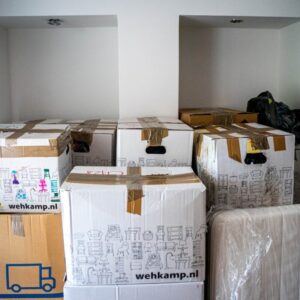
Moving is a chore you want to avoid. Such a hassle! Home buying, leaving a familiar place, and missing family and friends. Packing is one of the dreaded jobs you need to do when you move, a chore that may seem overwhelming. But you can de-stress with our packing tips.
Priorities
What to do first? You have too many things to think about. Everything about moving jostles for your attention. Some basics are in order, namely you and your family. Your priority during a move to your new home is to keep your valuables safe. Not just the tangible ones such as jewelry, but those affecting your identity.
Birth certificates, wedding licenses, and other important papers can get lost during a move. Make copies of critical papers to take with you and copies to pack for safekeeping. For an added safety measure, scan your essential papers and add the scans to an online cloud service such as OneDrive or Dropbox. Have precious memories you can’t lose? Scan photos, school art, and other ephemeral paper treasures.
Clutter
There’s so much stuff. How did all this stuff get here? You could have sworn you were more organized. Things you own seem to multiply like dust bunnies and collect those pesky balls of dirt.
When you move to your new home, you can make your move easier by decluttering. Giving away things you don’t need or don’t use simplifies the packing process. When you own fewer things, you’ll have fewer things to pack and move. Give to a thrift shop, sell at a garage sale, or donate to a local charity the things that clutter your life. For large, broken items, junk removal is essential.
Decluttering and getting rid of things mean your move will cost less because moving companies charge for distance and weight.
Sort Things by Category
Organization in the middle of house hunting often goes by the wayside. You mean to get organized, but when do you have the time to actually do it? Organization, however, is the key to a more pleasant move. Before packing, sort your things by category. You can find your things quickly when you put similar things together. For example, categorize books by their subject when you pack them. Put cookbooks with other cookbooks, books about crafts, fiction, etc. in separate boxes. The same applies to computer peripherals, sports equipment, and other possessions.
Pack Decorative Items and Toys Early
Fragile items are usually the ones you dread packing. A precious valuable, a sentimental gift, memories you would regret losing or breaking. Then there are the things you dread packing such as holiday lights or other decorative items. Pack these first. You won’t need them for a while, so pack them before everything else. Box up seasonal items, rarely used gadgets, and items you store in the attic or basement.
Many decorative items are fragile and packing these early means less risk of breaking or losing precious items. For rare and valuable objects, consider a professional packer to ensure they get to your new home in one piece.
Keep Your Electronics Boxes
Advice to toss things out when you’re done with them has exceptions. Keeping organized is easier when you have the original boxes. After you buy electronics such as a microwave or vacuum, stash the box. You can use the boxes to pack your electronics when you move. Bonus points for having the instruction manuals, but no one is keeping score on your house move. You can often find instruction manuals online, and not having the original paper copies helps cut down on clutter.
Packing and Moving Supplies
The amount of packing and moving supplies you will need for the move depends on several factors. These include:
Number of Rooms and Square Footage
The more rooms you have, the more stuff you’re likely to have. A teeny, tiny studio or one-bedroom will cost a lot less than a six-bedroom house. Look for online moving box calculators to determine how many boxes you need. Some moving box calculators are based on the square footage of your home.
Number of Years in Your House
You’ve been at the same house for many years and have a lot of fond memories. With those fond memories comes a lot of stuff. How long you’ve lived in a house can help you with the approximate number of boxes you’ll need.
Label Moving Boxes
Where did I put that? It’s a familiar question when you’re moving and home buying. It’s essential to label the boxes. Label the contents of the boxes and the room in your new home where you want to put those contents. Mark the sides and tops of the boxes.
Protect Items
Afraid of spills or things breaking? Pack your possessions carefully for your new home. Use bubble wrap, paper tissue, and blankets to cushion fragile items. Pack your dishes vertically. The weight of dishes packed on top of each other can crush the bottom dishes.
Check with the moving company if they transport liquids and pack these as carefully as you would fragile items. Pack liquids inside zip gallon bags. For personal items such as shampoo or similar containers, tighten the shampoo spout, wrap plastic cling wrap (Saran Wrap) around the spout, and tape the plastic cling wrap.
Extra Boxes
It’s easy to miss things at the last minute. Have extra boxes for odds and ends—the items you missed in your initial packing. There’s always one more thing you forgot, and you can pack it at the final moment with extra boxes.
Pack an Overnight Bag
Remember, finally, to take care of yourself when you are home buying and when you move into your new home. Pack an overnight bag with necessary clothes for a few days after the move and any toiletries you need. Self-care is critical for having a successful move. Not being stressed can help you focus and plan your move better. Take these tips to heart and your home move will be easier.




